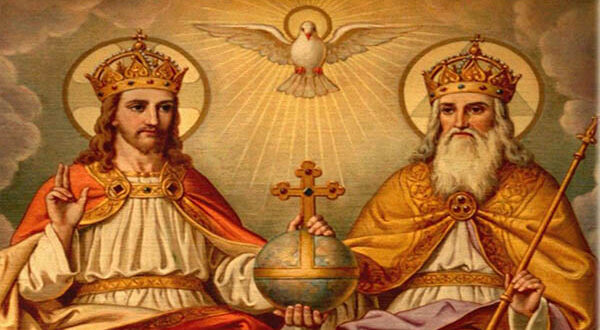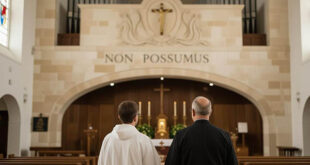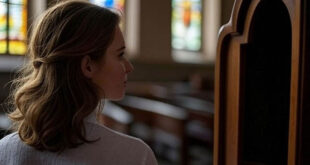A spiritual guide to understanding the divine heart of Christianity
Introduction: When God Dances with Himself
There are words that, although they do not literally appear in the Bible, open a door to the deepest mysteries of the Christian faith. One of them is perichoresis. This term, little known to the general public but central to Trinitarian theology, describes the intimate communion of love between the Father, the Son, and the Holy Spirit. It is not merely an abstract philosophical idea, but a living, dynamic, burning principle that can transform our spiritual life, our relationships, and our understanding of God.
Perichoresis is, in essence, the eternal “dance” of mutual love within the Trinity. A love that does not exclude, but overflows outward, inviting each one of us to participate. What are the implications of this for our daily life? How can such an unfathomable mystery inspire us today?
Let us immerse ourselves in this divine dance.
1. Etymology and Meaning: What Does ‘Perichoresis’ Mean?
The word perichoresis comes from the Greek:
- peri (περί): “around”
- chóresis (χωρέω): “to contain,” “to make room,” “to give space,” or, according to another interpretative root, “to move around”
Although there is no definitive consensus on its exact etymology, many Greek Fathers understood perichoresis as an image of dynamic interpenetration, of co-indwelling without confusion. Each Person of the Trinity dwells in the other two perfectly, without losing identity or becoming mixed.
St. John Damascene (8th century), Doctor of the Church, was one of the first to employ this term with theological precision, stating that “the three persons exist in one another without confusion or separation.” This is the foundation of our understanding of the One and Triune God.
2. Theological History: From the Fathers to the Magisterium
Although the word perichoresis was fully developed in Greek patristic theology, the concept has been present from the beginning. In the Gospel of John, we already find a clear hint:
“I am in the Father and the Father is in me.” (John 14:10)
This mutual indwelling was the starting point for the Eastern Fathers, such as Gregory of Nyssa and Basil the Great, to develop a vision of the Trinity as a living communion. Against the danger of conceiving God as three separate gods (tritheism), or as mere modes of a single person (modalism), perichoresis ensured unity without sacrificing distinction.
In the 13th century, St. Thomas Aquinas took up this vision with philosophical rigor in his Summa Theologiae, explaining how the Divine Persons are distinguished by their relations, but share the same divine essence. In his words:
“The divine Persons are in each other by reason of circuminsession.” (ST I, q.42, a.5)
Western theology sometimes used the term circumincession (Latin for perichoresis) to express the same reality. In both cases, the mystery is not a logical puzzle, but a hymn to love that gives and receives eternally.
3. The Trinity as an Eternal Dance of Love
Imagine a circle with no beginning and no end. No hierarchy, no selfishness, no competition. Only communion, self-giving, perfect reciprocity. That is perichoresis: the Father gives His whole being to the Son, the Son gives Himself to the Father, and this love is so real, so alive, so personal… that it is the Holy Spirit.
This “eternal dance” is not stillness, but movement. Not fusion, but relationship. The Trinity is not a divine monologue, but an eternal dialogue of love. And the most wonderful thing is that we are called to enter into that dialogue.
As St. Augustine said, the Holy Spirit is the “bond of love” between the Father and the Son (vinculum amoris), and this same Spirit dwells in our hearts by the grace of Baptism (cf. Romans 5:5).
4. Pastoral Implications: Why Should This Matter to You Today?
a) A Model for Human Relationships
If God in His very essence is communion, then all human life finds its fullness in communion. Family, friendship, marriage, community life: all our relationships are called to reflect this Trinitarian reality.
Perichoresis teaches us that to be a person is to be in relationship. We do not exist as islands, but as beings open to others.
b) A Key to Unity in the Church
In a fragmented world, where even Christians are divided, perichoresis is a powerful reminder: unity does not mean uniformity, but love that embraces diversity.
Just as the Father, the Son, and the Holy Spirit are distinct but inseparable, so too are we, with our charisms and sensibilities, called to live in unity of faith, hope, and love.
c) An Inspiration for Spiritual Life
Prayer ceases to be a solitary exercise and becomes participation in Trinitarian life. As St. Paul says:
“It is no longer I who live, but Christ who lives in me.” (Galatians 2:20)
Through sanctifying grace, we are inserted into the very heart of this mystery. Our soul, if in a state of grace, is a “dwelling place” of the Trinity (cf. John 14:23). Every time we pray, love, serve… we are dancing in the rhythm of God.
5. Practical Applications: Living Perichoresis Today
- In Your Personal Prayer: Pray in a Trinitarian key. Address the Father through the Son in the Holy Spirit. Feel that you are not speaking to a distant God, but participating in an eternal dialogue of love.
- In Your Family: Be inspired by Trinitarian communion. Reflect that mutual self-giving, that unconditional acceptance, that love which does not close in on itself.
- In Your Christian Community: Promote unity without erasing diversity. Listen, collaborate, dialogue. Let perichoresis not be just a concept, but an ecclesial experience.
- In Your Daily Decisions: Ask yourself: Am I acting from the logic of ego or from the logic of relational love? The Trinity invites us to go out of ourselves.
6. A Mystery That Transforms Us
Understanding perichoresis is not about solving a mathematical formula, but about opening the soul to a mystery that envelops us. Like when one lets oneself be carried away by music that cannot be explained but can be lived.
The Catechism of the Catholic Church summarizes this mystery with beautiful words:
“God is love: in Himself He lives a mystery of personal communion of love. Creating us in His image… God has destined us to participate in His own life.” (CCC 2331)
So the next time you make the Sign of the Cross, do it with this awareness: you are invoking a God who is relationship, who is pure love, who created you not for loneliness, but to dance with Him eternally.
Conclusion: The Invitation to the Heart of God
Perichoresis is not a theological luxury reserved for scholars. It is a personal calling. It is the very heartbeat of God. And you are invited to enter into that rhythm.
The Trinity is not a riddle. It is home. It is family. It is love in motion. And every time you love like Jesus, forgive like the Father, or comfort like the Holy Spirit, you are dancing in that mystery. You are participating in the eternal “dance” of God.
Will you dare to be swept up in it?
“That they may all be one, as you, Father, are in me and I in you, that they also may be in us.”
(John 17:21)






